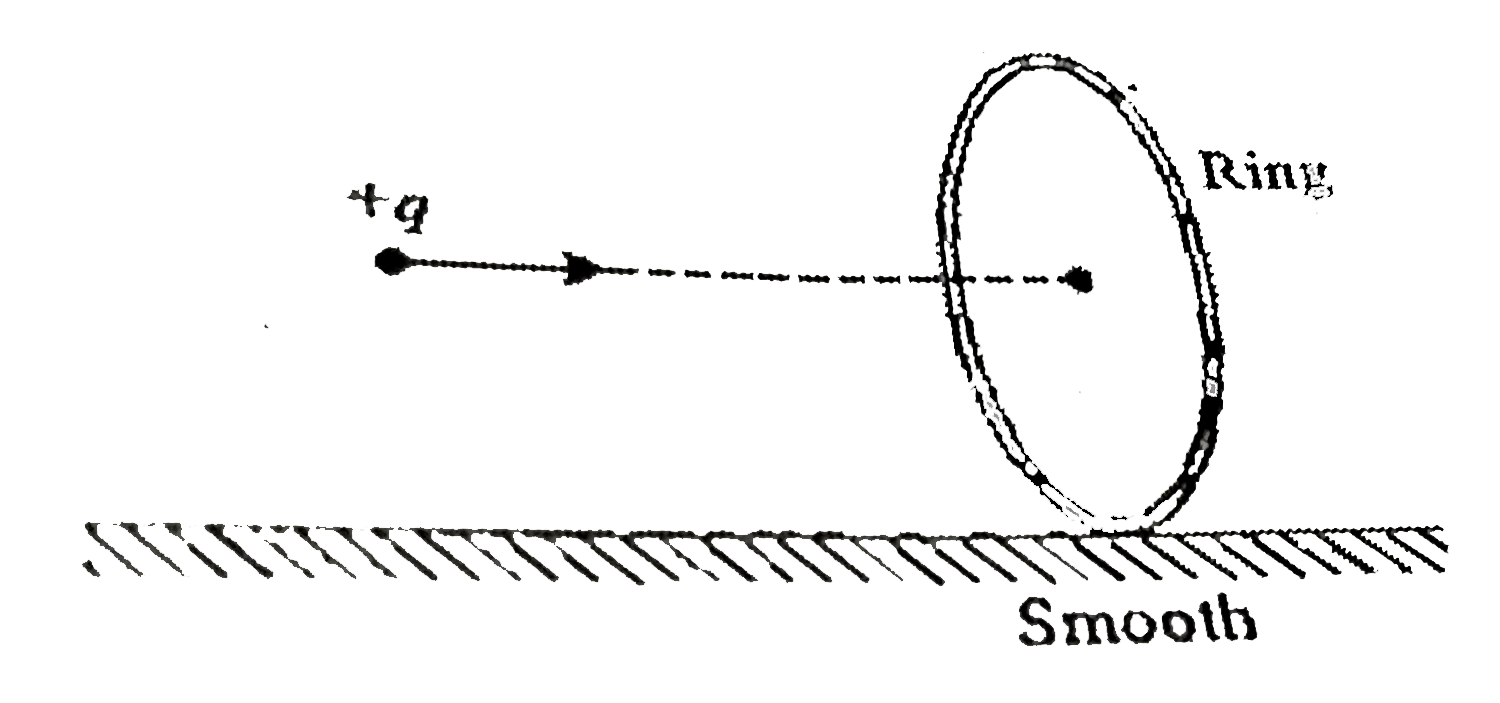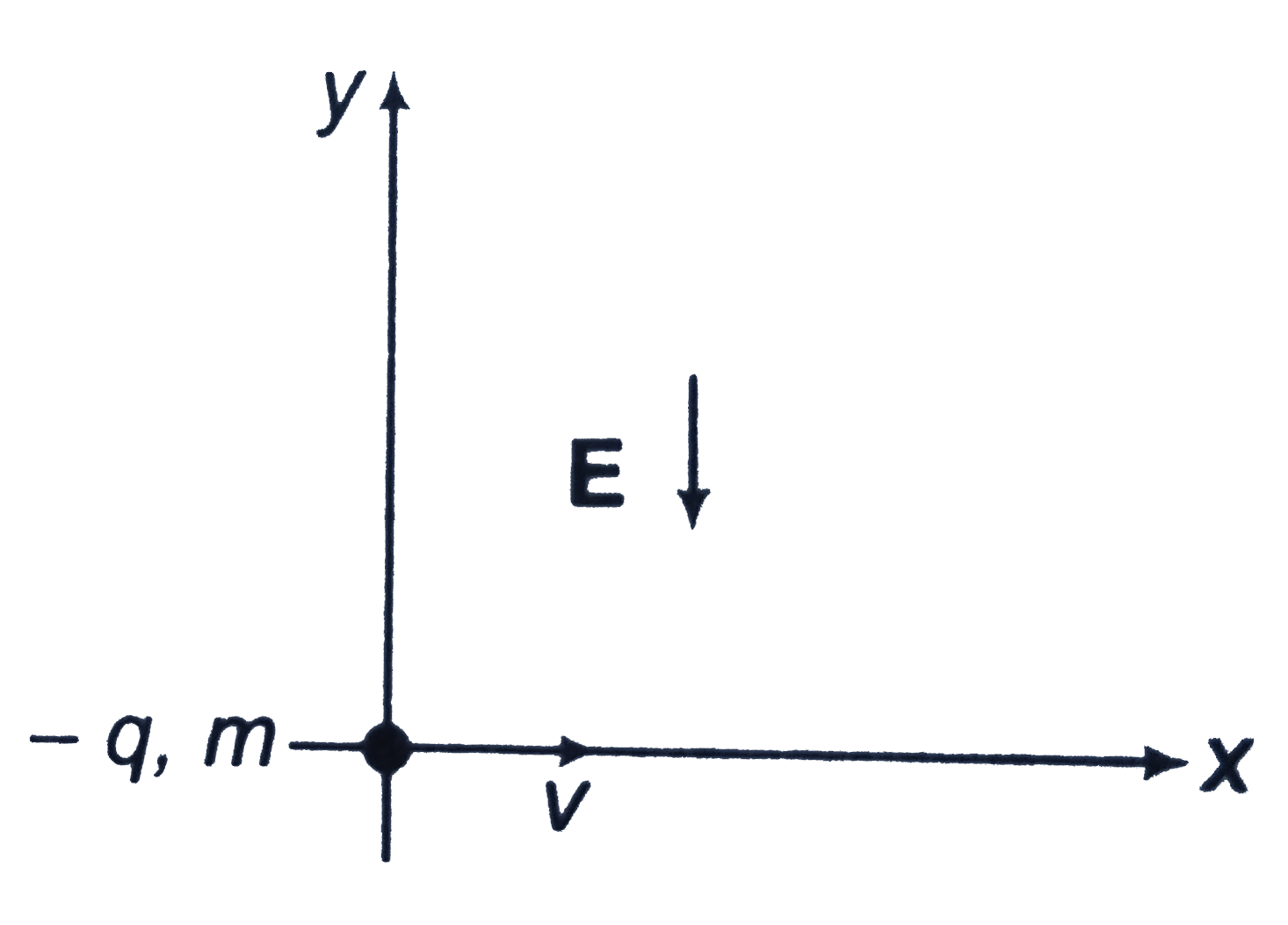A proton of mass m and charge e is projected from a very large distance towards an α−partic≤ with velocity v. Initially α−partic≤ is at rest, but it is free to move. If gravity is neglected, then the minimum separation along the straight line of their motion will be
e24πε0mv2
5e2πε0mv2
2e2πε0mv2
4e2πε0mv2
To solve the problem of finding the minimum separation between a proton and an alpha particle during their interaction, we can follow these steps:
1. Identify the Given Information:
- Mass of the proton = m
- Charge of the proton = e
- The alpha particle is at rest and has a mass of 4m (since an alpha particle consists of 2 protons and 2 neutrons).
- Initial velocity of the proton = v
- Initial velocity of the alpha particle = 0
2. Apply Conservation of Momentum:
- Before the interaction, the total momentum is given by:
Pinitial=mv+0=mv
- After the interaction, let the velocity of the proton be v′ and the velocity of the alpha particle be V. The total momentum after the interaction is:
Pfinal=mv′+4mV
- By conservation of momentum, we have:
mv=mv′+4mV
- Dividing through by m:
v=v′+4V(1)
3. Apply Conservation of Energy:
- The initial kinetic energy of the proton is:
KEinitial=12mv2
- At the point of closest approach, the kinetic energy will be converted into potential energy and the remaining kinetic energy of both particles:
KEfinal=12mv′2+12(4m)V2+ke2r
- Here, ke2r is the potential energy at the minimum separation r, where k=14πϵ0.
- Setting the initial kinetic energy equal to the final kinetic energy plus potential energy:
12mv2=12mv′2+12(4m)V2+ke2r(2)
4. Substitute v′ from Equation (1) into Equation (2):
- From (1), we can express v′ as:
v′=v−4V
- Substitute v′ into the energy equation (2):
12mv2=12m(v−4V)2+2mV2+ke2r
5. Simplify the Equation:
- Expanding the equation:
12mv2=12m(v2−8vV+16V2)+2mV2+ke2r
- Rearranging gives:
12mv2=12mv2−4mvV+9mV2+ke2r
- Canceling 12mv2 from both sides:
0=−4mvV+9mV2+ke2r
6. Solve for r:
- Rearranging gives:
ke2r=4mvV−9mV2
- Thus:
r=ke24mvV−9mV2
7. Final Expression:
- Substitute k=14πϵ0 and simplify to find the minimum separation r.
- Mass of the proton = m
- Charge of the proton = e
- The alpha particle is at rest and has a mass of 4m (since an alpha particle consists of 2 protons and 2 neutrons).
- Initial velocity of the proton = v
- Initial velocity of the alpha particle = 0
- Before the interaction, the total momentum is given by:
Pinitial=mv+0=mv
- After the interaction, let the velocity of the proton be v′ and the velocity of the alpha particle be V. The total momentum after the interaction is:
Pfinal=mv′+4mV
- By conservation of momentum, we have:
mv=mv′+4mV
- Dividing through by m:
v=v′+4V(1)
- The initial kinetic energy of the proton is:
KEinitial=12mv2
- At the point of closest approach, the kinetic energy will be converted into potential energy and the remaining kinetic energy of both particles:
KEfinal=12mv′2+12(4m)V2+ke2r
- Here, ke2r is the potential energy at the minimum separation r, where k=14πϵ0.
- Setting the initial kinetic energy equal to the final kinetic energy plus potential energy:
12mv2=12mv′2+12(4m)V2+ke2r(2)
- From (1), we can express v′ as:
v′=v−4V
- Substitute v′ into the energy equation (2):
12mv2=12m(v−4V)2+2mV2+ke2r
- Expanding the equation:
12mv2=12m(v2−8vV+16V2)+2mV2+ke2r
- Rearranging gives:
12mv2=12mv2−4mvV+9mV2+ke2r
- Canceling 12mv2 from both sides:
0=−4mvV+9mV2+ke2r
- Rearranging gives:
ke2r=4mvV−9mV2
- Thus:
r=ke24mvV−9mV2
- Substitute k=14πϵ0 and simplify to find the minimum separation r.
Similar Questions
A particle of mass m and charge +q approaches from a very large distance towards a uniformly charged ring ofradius Rand charge, mass same as that of particle, with initial velocity v0 along the axis of the ring as shown in the figure-1.420. What is the closest distance of approach between the ring and the particle? Assume the space to be gravity free and frictionless :
 View Solution
View SolutionA particle (A) having charge Q and mass m is at rest and is free to move. Another particle (B) having charge q and mass m is projected from a large distance towards the first particle with speed u. (a) Calculate the least kinetic energy of the system during the subsequent motion. (b) Find the final velocity of both the particles. Consider coulomb force only.
View Solution
Knowledge Check
- Question 1 - Select One
A proton of mass m and charge e is projected from a very large distance towards an α particle with velocity v. Intially, particle is at rest, but it is free to move. If gravity is neglected, then the minimum separation along the straight line of their motion will be
Ae2/4πε0mv2B5e2/4πε0mv2C2e2/4πε0mv2D4e(2)/4πεmv2 - Question 2 - Select One
A particle of mass m and charge −q is projected from the origin with a horizontal speed v into an electric field of intensity E directed downward. Choose the wrong statement. Neglect gravity
 AThe kinetic energy after a displacement y is qEyBThe horizontal and vertical components of acceleration of ax=0,ay=qEmCthe equation of trajectory is y=12(qEx2mv2)DThe horizontall and verticasl displacements x and y after a time t x=vt and y=12ayt2
AThe kinetic energy after a displacement y is qEyBThe horizontal and vertical components of acceleration of ax=0,ay=qEmCthe equation of trajectory is y=12(qEx2mv2)DThe horizontall and verticasl displacements x and y after a time t x=vt and y=12ayt2 - Question 3 - Select One
A particle of mass m is projected upword with velocity v=ve2 (ve) escape of the particle is
A−GMm2RB−GMm4RC−3GMm4RD−2GMm3R
The ratio of specific charge (e/m) of a proton and that of an α-particle is:
View SolutionA particle having charge +q and mass m is approaching (head on) a free particle having mass M and charge 10 q. Initially the mass m is at large distance and has a velocity V0, whereas the other particle is at rest.
(a) Find the final velocity of the two particles when M=20 m.
(b) Find the final state of the two particles if M=m.
 View Solution
View SolutionThe ration of spectific charge ( e//m) of a proton to that of an alpha-particle is :
View SolutionThe closed distance of approach of an α− particle travelling with velocity V towards a stationary nucleus is d.For the closest distance to become d3 towards a stationary nucleus of double of the charge,the velocity of projection of the α− particle has to be
View SolutionA particle of mass m is projected at an angle α to the horizontal with an initial velocity u. The work done by gravity during the time it reaches its highest point is
View Solution

